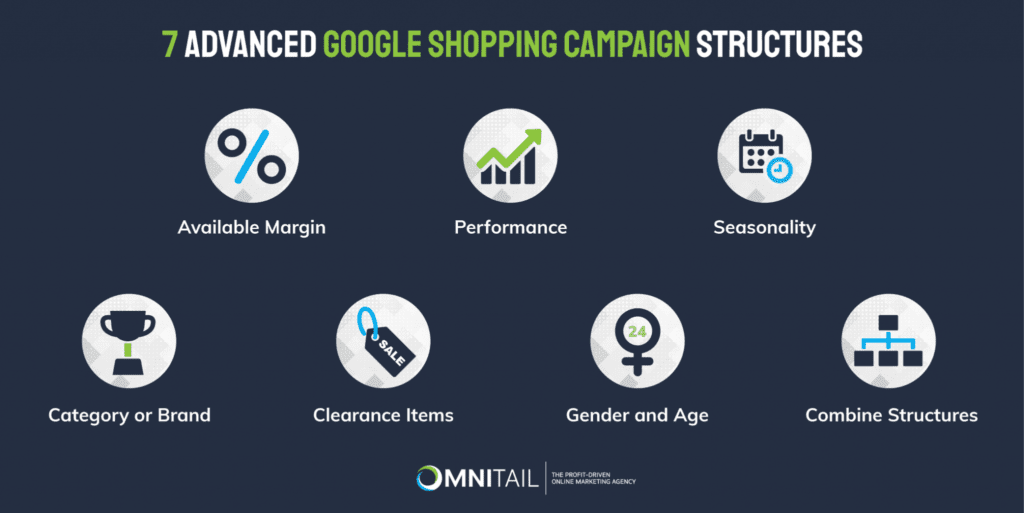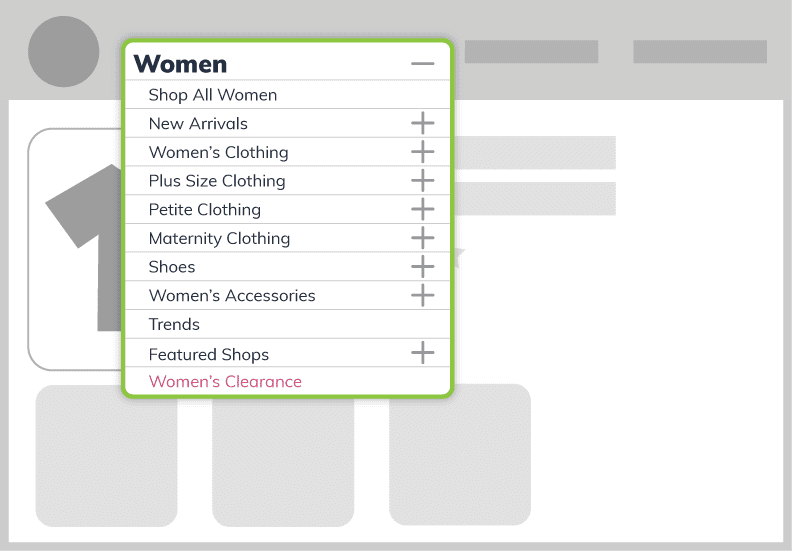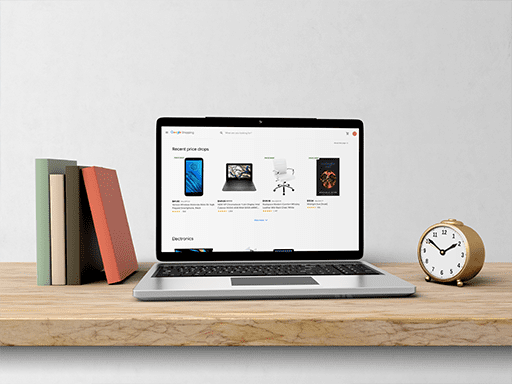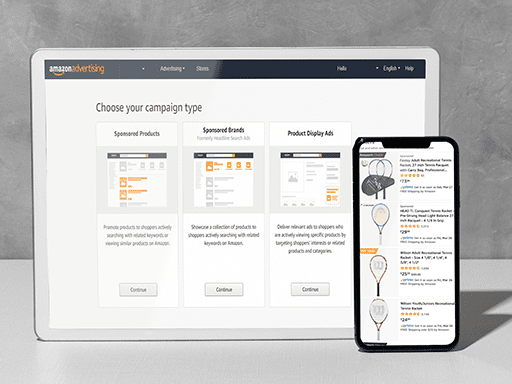If you want to grow profit on Google Shopping, a one ad group campaign probably isn’t the right structure for the job. To truly grow your business (and spend your ad dollars wisely), you need to structure to your Google Shopping campaigns.
But what Google Shopping campaign structure should you use?
At Omnitail, we structure our clients campaigns into multiple ad groups by segmenting them according to different dimensions.
In this blog, you’ll learn 7 of the most common dimensions we use to segment and structure Google Shopping campaigns (that actually grow profit). We’ll explain why these structures work and how to apply them in your Google Shopping account!

Don’t have time to read the whole blog? Check out our intro to advanced product segmentation. In this video we cover the basics of the campaign structures discussed in this blog:


1. Available Margin
Available margin (or, the profit potential of each segment) is one of the most effective ways to segment your Google Shopping campaigns. Why’s that?
Why You Should Segment By Available Margin
Imagine you have products with a 10% available margin in an ad group with products that have an 80% available margin. The profitability of these products is probably very different! If that’s the case, you shouldn’t bid the same amount for these products (which you are forced to do with a single ad group Google Shopping campaign structure).
How to Segment By Available Margin

Instead, you could put products with a 10% available margin in one ad group, and products with 80% available margin in another ad group. By segmenting by margin, you can see which products are driving sales. Then you can allocate more ad spend to those products. In the example above, this ad group has a 45% available margin.
Check out this blog to learn more about segmenting by margin.


2. Performance
Every business has products that sell better than others—and your business probably does too! It’s time to give them the respect they deserve with a brand new, exclusive ad group. Don’t lump them in with your other average products, or worse, weak-performers.
Why You Should Segment By Performance
Grouping products all together saves time, but wastes ad spend. By separating top performers and weak performers into distinct ad groups, you can spend more ad dollars on products you know sell well—and limit ad dollars wasted on weaker items.
Additionally, you will give other products a chance to become top performers. Sometimes, products that might otherwise be top-performers are grouped with weak items. As a result, these products lose impressions to top-selling products in the same ad group. These sleeper top-products then might look like under-performers, when in reality they’re just not being given a chance to appear.
How to Segment By Performance

To segment these products, label them as “weak item” or “hot item” in your feed to ensure they’re divided into corresponding product groups. There’s an art to segmenting by performance. We actually wrote an entire guide on it. Learn more about segmenting Google Shopping campaigns by performance.


3. Seasonality
We have a client who experiences extreme seasonality. They sell gifts for very specific holidays and events like “Teach Appreciation Week” and “National Picnic Month”. This posed a challenge, but a effective Google Shopping campaign structure proved to be just what their campaigns needed to take off. If you want to learn how we tackled their uniquely challenging seasonality, you can read the case study here.
Why You Should Segment By Seasonality
You most likely won’t need to go as far as we did—but it does help to create different ad groups for your seasonal products. Doing so allows you to quickly locate and adjust ad group bids depending on peak season.
This also limits wasted advertising spend. Because your seasonal products are segmented out, you can pull all seasonal ad groups and adjust them without fear that aggressive increases will lead to wasted ad spend on other products.
How to Segment by Seasonality

To segment according to certain dates (like October 1st to 31st), you can append a date range like “10.01-31” to products in the feed. This will help ensure those products are segmented into a different ad group, so they serve during their peak season. Then you can lower bids to or turn off those ad groups when they are out of season.


4. Category or Brand
If you sell clothes, you could segment your ad groups by type of clothing. For example, shirts, pants, skirts, jackets, etc. Structuring your Google Shopping campaigns according to category might be an obvious choice if your products have clearly defined categories.
Why You Should Segment By Category
Segmenting by category is an easy way to segment your products, but can also improve your bidding strategy. If one brand has better margins, for instance.
Additionally, items in the category probably tend to sell relatively similarly. For example, the purchase behavior for something like a pool pump that you need to buy once (hopefully) over several years is going to be different than the chlorine which you need to regularly purchase for your pool.
How to Segment by Category

The navigation or menu on your website is a good place to start if you want to segment by category. Odds are your products are already divided into organized categories on your site to help your customers find your products—you can copy those same categories and apply them to campaign structure on Google Shopping!


5. Clearance Items
Do you often run sales or have clearance items? Sale or clearance items are also great candidates for segmentation since they often require a different bidding strategy than full-price items.
Why You Should Segment Out Clearance Items
Sales items typically have weaker margins and inventory. Therefore you need to treat them differently in your account structure. By separating sale items from the remainder of your stock, you can assign bids to them that will allow you to remain profitable or at least break even, although these items are on clearance.
How to Segment Clearance Items

Differentiating clearance items isn’t much different than any of the previous strategies. Label these products in the feed, and ensure they’re added to a distinct product group. You may also want to make a note of any cost considerations – if the cost of goods is especially high for these items, for instance. Learn how to drive profit—even on clearance items.


6. Gender or Age
For retailers who sell apparel, structuring your Google Shopping campaigns by gender and/or age group is important.
Why You Should Segment By Gender
Performance varies between different age groups and genders, producing a wide range of sales and revenue. Depending on what you sell, some seasonality might factor in as well.
You would probably expect items for women to sell well around Mother’s Day, and those for men to sell better closer to Father’s Day, for example.
How to Segment By Gender or Age

Imagine you sell men’s watches, women’s watches, and unisex watches. Google already requires you to denote these attributes in your feed, so it’s a short step from there to ensuring your products are segmented effectively. We suggest creating a product group for each of those categories by appending the correct category to each item in the feed.


7. Combine Google Shopping Campaign Structures
This is just a starting point for segmenting your campaigns! As we said, there’s an unlimited number of ways you can segment your Google Shopping campaigns—you just need to find the way that works best for your business. We recommend using a combination of these segmentation strategies.

Example of Combining Strategies
For example, a jewelry seller might segment by men’s, women’s, and unisex. Within these categories, they might divide the products according to available margin. Then, they could have a separate ad group for top performers and weak performers. During the holidays, they sell festive-themed jewelry, so they put those products in a seasonal ad group. See how these different strategies can overlap?

How will you structure your Google Shopping campaigns?
You can do the same for your business! Now that you have an idea of how to segment your products, you can take it a step further. How many products should you have per ad group?
Read more about organizing Google Shopping campaigns here.
Need help finding your ideal campaign structure?
We’re happy to help. Contact us for a free strategy call today.








